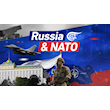NATO eyeing 'military Schengen' for personnel, equipment exchange
Planners within the bloc have expressed criticism of bureaucratic obstacles hindering the cross-border exchange of military equipment, as per The Times report.
-

Paratroopers from the KSK (Kommando Spezialkraefte) special unit of Germany's armed forces taking part in a military exercise in Ahrenvioelfeld, northern Germany. (AFP)
Efforts are being made to establish a system of "military Schengen" across Europe, aiming to circumvent intricate regulations that currently limit the exchange of equipment and personnel among NATO nations, The Times reported on Sunday.
In November, Lieutenant-General Alexander Sollfrank, NATO's European logistics chief, encouraged countries in the region to create zones that would facilitate the swift movement of troops and ammunition in the event of a significant conflict with Russia.
The notion of establishing "military corridors" has been discussed by military leaders for years, and according to The Times, current talks on creating these corridors are in progress, with potential announcements expected before NATO's next summit in July.
The complex set of regulations in the EU that hampers the exchange and transportation of military equipment has posed a significant challenge for NATO planners, as per The Times.
”Cross-border exercises frequently involve dizzying quantities of paperwork that would cost critical time in a military crisis,” it added.
Lt. Gen. Alexander Sollfrank emphasized, as cited by The Times, the urgent need for NATO member countries to initiate efforts immediately to "reduce or adapt the red tape" hindering military coordination.
”Everyone can start. Just do it. And don’t wait. Because in the end, we have no time to waste,” he warned.
The logistics chief cited the example of paratroopers being forbidden from using parachutes belonging to other member states, even when there is no justification for such a restriction.
“Where’s the problem, for example, with a paratrooper from a European nation A using a parachute from a neighboring nation B after having been trained on this system, or attaching equipment from one nation to the helicopter of another nation?” he asked. If there are no “technical or security” issues involved, there should be no impediments, he said.
Nevertheless, Lieutenant General Jan-Willem Maas, the head of Defense Support Command for the Dutch armed forces, stated to The Times that there is still significant preparation required. "We are not at the level we should be. That is evident," he remarked.
In the past few weeks, high-ranking officials in various European countries have advised their populations to prepare for a possible military conflict with Russia.
Germany warns of Russian 'attack' on NATO within ‘5-8 years’
German Defense Minister Boris Pistorius, on January 20, warned that Russian President Vladimir Putin could pull an attack on a NATO country “within 5-8 years.”
"We hear threats from the Kremlin almost every day ... so we have to take into account that Vladimir Putin might even attack a NATO country one day," Pistorius said in an interview with the Berlin-based Der Tagesspiegel newspaper.
The Minister added that even though a "Russian attack is not likely for now... our experts expect a period of five to eight years in which this could be possible."
Pistorius' comments align with warnings from Sweden's Minister for Civil Defense, Carl-Oskar Bohlin, who last week cautioned that "war could come to Sweden."
In an interview for Der Tagesspiegel, Pistorius expressed understanding of the Swedish warnings, noting that they were "understandable from a Scandinavian perspective." He further emphasized that Sweden confronted "an even more serious situation" due to its geographical proximity to Russia.
Moscow has consistently asserted that it has no intention of engaging in warfare against NATO, with Russian President Vladimir Putin dismissing the alerts as "nonsense" and emphasizing that Moscow has "no interest" in attacking any members of the bloc.
Read more: Reduced US aid to Ukraine sends 'bad' signal, warns Zelensky

 4 Min Read
4 Min Read









